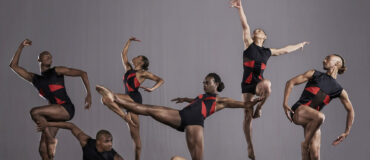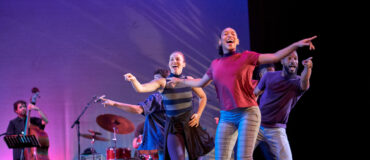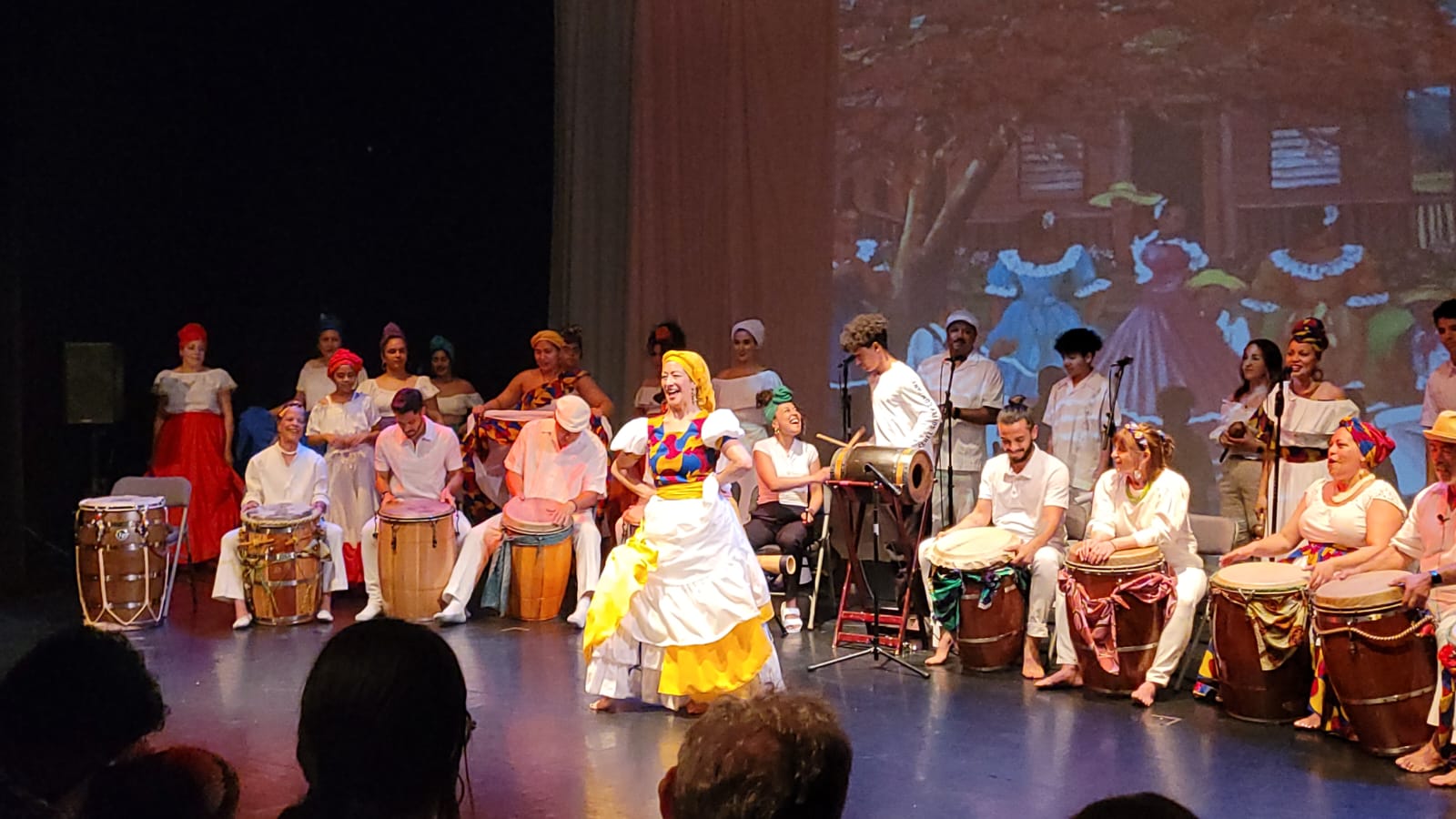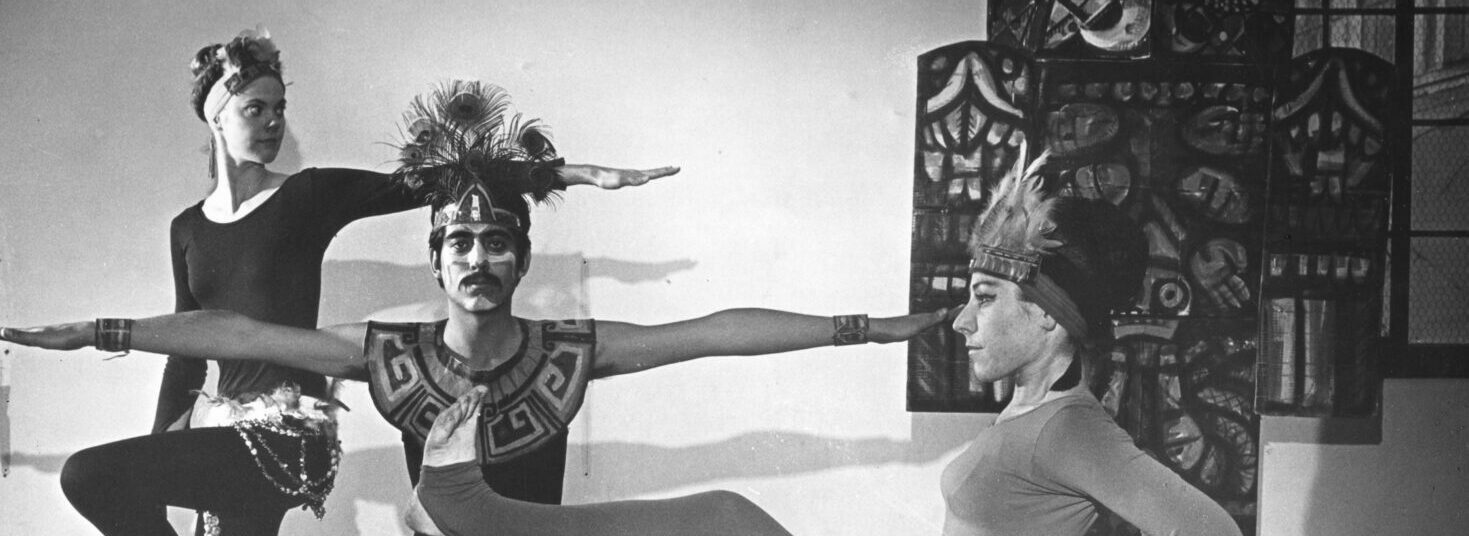Archiving Fellowships Blog: Segunda Quimbamba Folkloric Center, Part 4
By Abdiel Jacobsen
Abdiel Jacobsen is a 2023 Archiving and Preservation Fellow with Segunda Quimbamba Folkloric Center. Read more about the Fellowships here. This is the fourth part of Abdiel’s blog; read the third part here.
A Day Outside of SQFC with 2Q in Performance
My day started bright and early at 8:30 a.m Thursday morning arriving at Segunda Quimbamba Folkloric Center (SQFC). I helped Juan and Nanette load various instruments into their car–a bag of maracas, a bag of güiros, a few panderos, cua along with a stand, and two bariles de bomba (subidor and buleador). We were making two stops in New Jersey, one in Voorhees and the other in Moorestown.
The first stop was at Bancroft Flicker Residences for Older Adults in Voorhees, NJ. The Judith B. Flicker Residences Program is aimed at providing a superior quality of life for people over 50 with autism and intellectual or developmental disabilities, in a serene setting in Voorhees, New Jersey. Programming is aimed at meeting the diverse needs, interests, and activity levels of older and aging adults—keeping them engaged and supported while respecting their individual needs and desires. The therapeutic activities coordinator, Linda Miller, greeted us with warmth and enthusiasm as we arrived. I noticed there were several people with disabilities present and several of the assistants that worked there accompanied them. Juan and Nanette set up the percussion in the small activities room facing an intimate audience of about 20 people eagerly waiting.
Juan and Nanette began with an introduction to give background on Bomba, sharing historical traditions around the practice quite effortlessly. They discussed the regions and the time period it emerged, each instrument and its significance, the costumes (Nanette wore some of the traditional garments including the skirt and headwrap), and the lyrics and their meanings. After lecturing about each topic, they would demonstrate and engage the audience by having them participate, whether through clapping, singing the rhythms, or learning some of the dance steps. The audience members immediately lit up when Nanette handed them maracas to play the rhythms along with them. There was one audience member who I later learned had autism who was cheering vigorously because of his excitement at the sounds he made when he played the maraca. When Nanette asked for volunteers to join in the call and response exchange between dancer and primo drummer, there was one older member who performed the piquetes (improvised dance movements towards primo drummer) with confidence and concentration. Limbs extended with sharpness, feet pounded the floor, knees bent and lifted with dynamism, shoulders shook and rolled with fierce articulation.
It was a pleasant surprise to see many of these elderly members so engaged with smiles and joyous claps and cheers. This lecture-demonstration format with audience participation allowed for a dynamic exchange that created a kinetic charge in the room. I just kept thinking about how Bomba and folkloric practices are quite accessible for many people of various ages and abilities to experience music in an embodied sense. How empowering! I later learned from Juan and Nanette that this is why senior living homes often invite them back and why they have a considerable network of senior living homes they perform at. 15 adults with intellectual disabilities over 50 attended and many, if not all, participated. I should also mention that Juan requested me to play besides him during most of the performance. I was a bit nervous at first, being that I only had one prior drum lesson. Juan’s confidence in me was encouraging and although I was limited in the rhythms I could play–basically yubá–I felt part of the experience in a way I never have before in my life as a musician. I experienced firsthand how playing the buleador while simultaneously watching the dancers conduct the primo drummer with their piquetes held an important responsibility of timekeeping to allow improvisation to occur while staying in a continuous pulse, holding together the rhythmic core of both the dance and the music. My hyperfocus contributed to the heightened presence of the moment.
The performance and lecture-demonstration lasted for an hour. After finishing, many came up to us expressing their gratitude. I was so moved. On a personal note, my father used to play his trumpet for senior homes throughout his retirement all the way up to just months before his recent passing in 2020. I accompanied my dad on a few of his performances and witnessed the sheer joy the senior members would express on their faces and bodies when my dad played old jazz standards and show tunes, many at their request that my dad performed by rote memory. They would sing along and get up and dance and my dad would speak with them about the songs, ask them what they remembered about the music he played, and crack a few jokes to get them laughing. This memory of my dad was revived through this Bomba demonstration by Segunda Quimbamba, reminding me of the importance of multicultural arts as engagement for our older and disabled communities.
On our way to our next location we took a rest stop in Collingswood, NJ and ended up passing by a boutique called “Galerie Marie” off of Haddon Avenue. They sold all sorts of items: clothing, artwork, artisan crafts, candles, crystals, and more. In a moment of serendipity we met the owner, Kimberly Camp, who was very kind and welcoming. Through Juan and Nanette’s conversation with her, she shared some of her vast knowledge on doll making, which we later learned she had received much acclaim for, including paintings and museum projects she created and directed at several leading museums. They invited her to attend their performance later that evening and, sure enough, she showed up with her friend and enjoyed the performance.
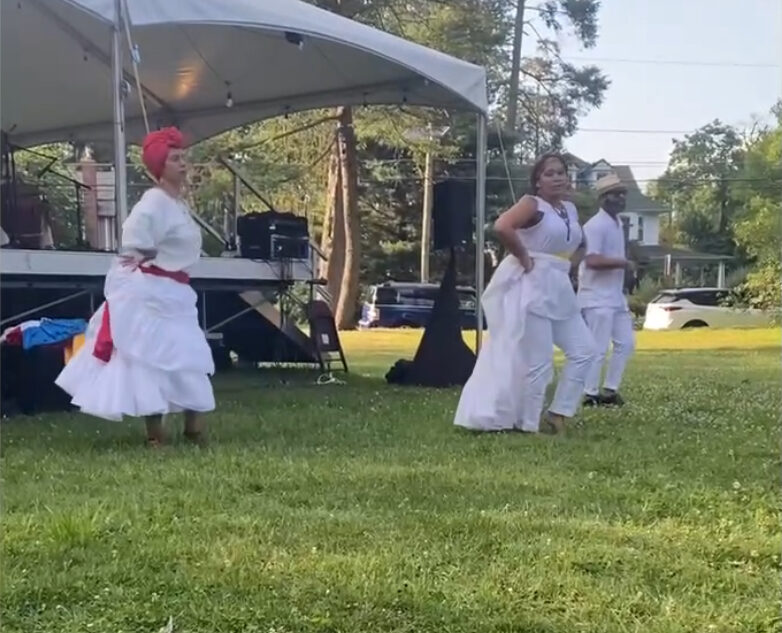
2Q members performing. From left to right: Tania Fermín, Saiya Forty, Hamlet Martínez
When arriving at the Perkins Center for the Arts in Moorestown, we set up outside in the backyard on the grass near the back entrance. The children from the summer camp program began to arrive with much chatter and gasps at the sight of the percussion instruments. Like the center for adult living we were at earlier, this was also an intimate group of attendees, but instead included children and teens from elementary and middle school grade level – about 20 to 25 in attendance. They sat on the grass and Juan and Nanette began the same format as they did at the senior center with me continuing to assist by playing the buleador barril. The children particularly enjoyed trying on the skirts and mimicking some of the dance movements Nanette led. Regardless of age, young or old, Bomba ignites an excitement in those who witness and participate.
Finally, the last event of the day was a free and open to the public performance at the Perkins Center for the Arts where the entire 2Q company traveled from New York City and Jersey City to perform with Juan and Nanette. A stage was set up outdoors and members from the local community began trickling in around 6pm. I took notes on the lineup of the performance:
- Verbal introduction of Bomba
- San Tomas rhythm with company demo
- Explanation of call and response between dancer and primo
- Teach audience members how to dance to San Tomas rhythm with audience participation
- Explanation of the piquetes with offerings of skirts for audiences to try dancing with if desired
- Plena introduction
- Demonstrate Plena tumbao
- “El Gallo Canta” performed
- Moved through the audience while playing Plena songs to demonstrate the mobile traditions of Plena played in parades and various festivities
- Lecture by Juan Cartagena about ancestral connection and cultural historical memory
- Play song
- Lecture by Nanette about SQFC’s 30-year history and an invitation to celebrate Afro-Puerto Rican culture
- Play Songs: “No Me Llores,” “Marcelina, ” and “Calindá”
- Invite audience to sing along the coro
- Introduce the full company and thank yous
- Finish with Plena dancing through the audience
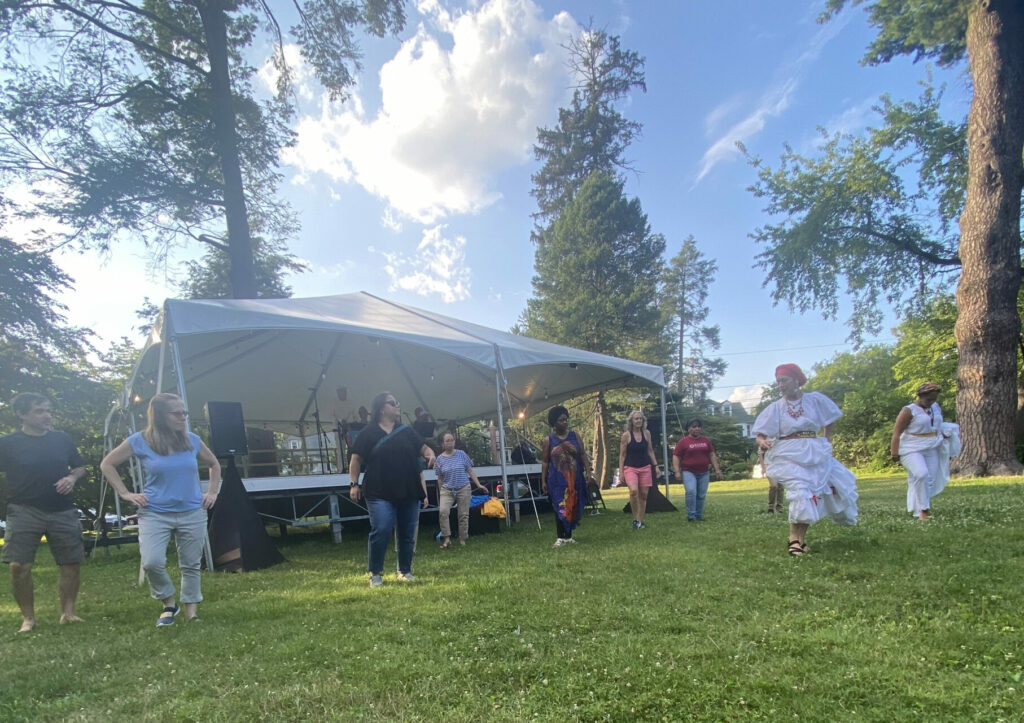
2Q members inviting audience participants to dance Bomba with them.
I appreciated throughout the performance the dancers and the speakers coming down off the stage to be level with the audience. Navigating proscenium theaters or raised stages can often be challenging when presenting dance forms that are not traditionally performed in that spatial relationship. The performance felt like more than just a show. It was a history lesson, a dance and music demonstration, and a dance class that engaged the audience towards a more immersive format. I recognized the potential to utilize the archives more robustly in 2Q’s performances formats. This could be another project after this initial archiving process of identifying, gathering, and organizing materials. So much of what makes Bomba and Plena engaging is its embodiment and necessity as a lived experience. I imagine the archives being engaged within immersive performance spaces/formats, or even developed in ethnotheatrical/ethnodramatic works, will keep the archives active within the company. For example, there could be images from their archives projected, voice recordings of interviews played with some of the influential artists they mention describing the dance and music, copies of paper materials such as of SQFC’s Güiro y Maraca newsletter by Juan Cartagena–the first-ever publication dedicated exclusively to discussing and documenting the happenings and histories of Bomba and Plena–read from, and artifacts such as posters, paintings and/or masks. The opportunity for archival activation via performance is rich.
What a day! Beginning at 8:30am and returning back to 2Q after 9:30pm, I was physically exhausted but my spirit was awake and full of gratitude to be able to witness and participate in a performance day with 2Q. I was impressed with Juan and Nanette’s endurance to deliver three performances with lecture-demonstrations in one day. Juan and Nanette’s individual and combined energy is enlivened with such vitality. Their long term commitment to Afro Puerto Rican folkloric practices shows. It is no wonder they have sustained a 30+ year legacy–and I don’t imagine them slowing down.
Header image: Dancer: Kiera Colon, 2Q Spring Recital, June 5, 2022. Photo credit: Mimi Montalvo
All other photos courtesy of the author.
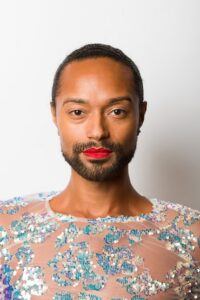 Abdiel Jacobsen (they/them) is a Hustle dance champion, educator, and community organizer dedicated to the cultural preservation and creative expansion of the New York Hustle partner dance style. As co-founder of “Dance is Life”–a communitarian free public dance party event– Abdiel creates space to facilitate human connection, communal healing, and celebration while revitalizing cultural historical sites where Hustle has been traditionally danced. Abdiel currently teaches their gender neutral approach to partner dance as a Pre Doctoral Lecturer at the University of Washington. They are also a former Fulbright Specialist with the US Dept. of State, Bureau of Educational and Cultural Affairs and a former Principal dancer of the Martha Graham Dance Company. Abdiel is looking forward to deepening their archival practices through the collaboration of the Segunda Quimbamba Folkloric Center and creating communitarian protocol for outreach, collection, and cataloging of crowdsourced materials. For more information on Abdiel: Instagram. Photo Credit: Warren Woo.
Abdiel Jacobsen (they/them) is a Hustle dance champion, educator, and community organizer dedicated to the cultural preservation and creative expansion of the New York Hustle partner dance style. As co-founder of “Dance is Life”–a communitarian free public dance party event– Abdiel creates space to facilitate human connection, communal healing, and celebration while revitalizing cultural historical sites where Hustle has been traditionally danced. Abdiel currently teaches their gender neutral approach to partner dance as a Pre Doctoral Lecturer at the University of Washington. They are also a former Fulbright Specialist with the US Dept. of State, Bureau of Educational and Cultural Affairs and a former Principal dancer of the Martha Graham Dance Company. Abdiel is looking forward to deepening their archival practices through the collaboration of the Segunda Quimbamba Folkloric Center and creating communitarian protocol for outreach, collection, and cataloging of crowdsourced materials. For more information on Abdiel: Instagram. Photo Credit: Warren Woo.
____
We accept submissions on topics relevant to the field: advocacy, artistic issues, arts policy, community building, development, employment, engagement, touring, and other topics that deal with the business of dance. We cannot publish criticism, single-company season announcements, and single-company or single artist profiles. Additionally, we welcome feedback on articles. If you have a topic that you would like to see addressed or feedback, please contact communications@danceusa.org.
Disclaimer: Opinions expressed in guest posts do not necessarily represent the viewpoints of Dance/USA.

